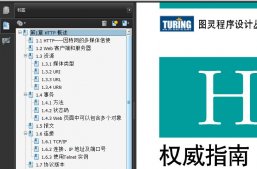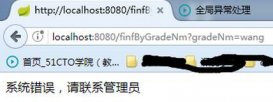簡介
spring cloud ribbon 是一個基于http和tcp的客服端負載均衡工具,它是基于netflix ribbon實現的。它不像服務注冊中心、配置中心、api網關那樣獨立部署,但是它幾乎存在于每個微服務的基礎設施中。包括前面的提供的聲明式服務調用也是基于該ribbon實現的。理解ribbon對于我們使用spring cloud來講非常的重要,因為負載均衡是對系統的高可用、網絡壓力的緩解和處理能力擴容的重要手段之一。在上節的例子中,我們采用了聲明式的方式來實現負載均衡。實際上,內部調用維護了一個resttemplate對象,該對象會使用ribbon的自動化配置,同時通過@loadbalanced開啟客戶端負載均衡。其實resttemplate是spring自己提供的對象,不是新的內容。讀者不知道resttemplate可以查看相關的文檔。
現象
前兩天碰到一個ribbon相關的問題,覺得值得記錄一下。表象是對外的接口返回內部異常,這個是封裝的統
一錯誤信息,spring的異常處理器catch到未捕獲異常統一返回的信息。因此到日志平臺查看實際的異常:
org.springframework.web.client.httpclienterrorexception: 404 null
這里介紹一下背景,出現問題的開放網關,做點事情說白了就是轉發對應的請求給后端的服務。這里用到了ribbon去做服務負載均衡、eureka負責服務發現。
這里出現404,首先看了下請求的url以及對應的參數,都沒有發現問題,對應的后端服務也沒有收到請求。這就比較詭異了,開始懷疑是ribbon或者eureka的緩存導致請求到了錯誤的ip或端口,但由于日志中打印的是eureka的serviceid而不是實際的ip:port,因此先加了個日志:
|
1
2
3
4
5
6
7
8
9
|
@slf4jpublic class customhttprequestinterceptor implements clienthttprequestinterceptor { @override public clienthttpresponse intercept(httprequest request, byte[] body, clienthttprequestexecution execution) throws ioexception { log.info("request , url:{},method:{}.", request.geturi(), request.getmethod()); return execution.execute(request, body); }} |
這里是通過給resttemplate添加攔截器的方式,但要注意,ribbon也是通過給resttemplate添加攔截器實現的解析serviceid到實際的ip:port,因此需要注意下優先級添加到ribbon的 loadbalancerinterceptor 之后,我這里是通過spring的初始化完成事件的回調中添加的,另外也添加了另一條日志,在catch到這個異常的時候,利用eureka的 discoveryclient#getinstances 獲取到當前的實例信息。
之后在測試環境中復現了這個問題,看了下日志,eurek中緩存的實例信息是對的,但是實際調用的確實另外一個服務的地址,從而導致了接口404。
源碼解析
從上述的信息中可以知道,問題出在ribbon中,具體的原因后面會說,這里先講一下spring cloud ribbon的初始化流程。
|
1
2
3
4
5
6
7
8
|
@configuration@conditionalonclass({ iclient.class, resttemplate.class, asyncresttemplate.class, ribbon.class})@ribbonclients@autoconfigureafter(name = "org.springframework.cloud.netflix.eureka.eurekaclientautoconfiguration")@autoconfigurebefore({loadbalancerautoconfiguration.class, asyncloadbalancerautoconfiguration.class})@enableconfigurationproperties({ribboneagerloadproperties.class, serverintrospectorproperties.class})public class ribbonautoconfiguration {} |
注意這個注解 @ribbonclients , 如果想要覆蓋spring cloud提供的默認ribbon配置就可以使用這個注解,最終的解析類是:
|
1
2
3
4
5
6
7
8
9
10
11
12
13
14
15
16
17
18
19
20
21
22
23
24
25
26
27
28
29
30
31
32
33
34
35
36
37
38
39
40
41
42
43
44
45
46
47
48
49
50
51
52
53
54
55
56
57
|
public class ribbonclientconfigurationregistrar implements importbeandefinitionregistrar { @override public void registerbeandefinitions(annotationmetadata metadata, beandefinitionregistry registry) { map<string, object> attrs = metadata.getannotationattributes( ribbonclients.class.getname(), true); if (attrs != null && attrs.containskey("value")) { annotationattributes[] clients = (annotationattributes[]) attrs.get("value"); for (annotationattributes client : clients) { registerclientconfiguration(registry, getclientname(client), client.get("configuration")); } } if (attrs != null && attrs.containskey("defaultconfiguration")) { string name; if (metadata.hasenclosingclass()) { name = "default." + metadata.getenclosingclassname(); } else { name = "default." + metadata.getclassname(); } registerclientconfiguration(registry, name, attrs.get("defaultconfiguration")); } map<string, object> client = metadata.getannotationattributes( ribbonclient.class.getname(), true); string name = getclientname(client); if (name != null) { registerclientconfiguration(registry, name, client.get("configuration")); } } private string getclientname(map<string, object> client) { if (client == null) { return null; } string value = (string) client.get("value"); if (!stringutils.hastext(value)) { value = (string) client.get("name"); } if (stringutils.hastext(value)) { return value; } throw new illegalstateexception( "either 'name' or 'value' must be provided in @ribbonclient"); } private void registerclientconfiguration(beandefinitionregistry registry, object name, object configuration) { beandefinitionbuilder builder = beandefinitionbuilder .genericbeandefinition(ribbonclientspecification.class); builder.addconstructorargvalue(name); builder.addconstructorargvalue(configuration); registry.registerbeandefinition(name + ".ribbonclientspecification", builder.getbeandefinition()); }} |
atrrs包含defaultconfiguration,因此會注冊ribbonclientspecification類型的bean,注意名稱以 default. 開頭,類型是ribbonautoconfiguration,注意上面說的ribbonautoconfiguration被@ribbonclients修飾。
然后再回到上面的源碼:
|
1
2
3
4
5
6
7
8
9
10
11
12
13
14
15
16
17
18
19
20
21
22
23
24
25
26
27
28
29
30
31
32
33
34
35
36
37
38
39
40
41
42
43
44
45
46
47
48
49
50
51
52
53
54
55
56
57
58
59
60
61
62
63
64
65
66
67
68
69
70
71
72
73
74
75
76
77
78
79
80
81
82
83
84
85
86
87
88
89
90
91
92
93
94
95
96
97
98
99
100
101
102
103
104
105
106
107
108
109
110
|
public class ribbonautoconfiguration { //上文中會解析被@ribbonclients注解修飾的類,然后注冊類型為ribbonclientspecification的bean。 //主要有兩個: ribbonautoconfiguration、ribboneurekaautoconfiguration @autowired(required = false) private list<ribbonclientspecification> configurations = new arraylist<>(); @bean public springclientfactory springclientfactory() { //初始化springclientfactory,并將上面的配置注入進去,這段很重要。 springclientfactory factory = new springclientfactory(); factory.setconfigurations(this.configurations); return factory; } //其他的都是提供一些默認的bean配置 @bean @conditionalonmissingbean(loadbalancerclient.class) public loadbalancerclient loadbalancerclient() { return new ribbonloadbalancerclient(springclientfactory()); } @bean @conditionalonclass(name = "org.springframework.retry.support.retrytemplate") @conditionalonmissingbean public loadbalancedretrypolicyfactory loadbalancedretrypolicyfactory(springclientfactory clientfactory) { return new ribbonloadbalancedretrypolicyfactory(clientfactory); } @bean @conditionalonmissingclass(value = "org.springframework.retry.support.retrytemplate") @conditionalonmissingbean public loadbalancedretrypolicyfactory neverretrypolicyfactory() { return new loadbalancedretrypolicyfactory.neverretryfactory(); } @bean @conditionalonclass(name = "org.springframework.retry.support.retrytemplate") @conditionalonmissingbean public loadbalancedbackoffpolicyfactory loadbalancedbackoffpolicyfactory() { return new loadbalancedbackoffpolicyfactory.nobackoffpolicyfactory(); } @bean @conditionalonclass(name = "org.springframework.retry.support.retrytemplate") @conditionalonmissingbean public loadbalancedretrylistenerfactory loadbalancedretrylistenerfactory() { return new loadbalancedretrylistenerfactory.defaultretrylistenerfactory(); } @bean @conditionalonmissingbean public propertiesfactory propertiesfactory() { return new propertiesfactory(); } @bean @conditionalonproperty(value = "ribbon.eager-load.enabled", matchifmissing = false) public ribbonapplicationcontextinitializer ribbonapplicationcontextinitializer() { return new ribbonapplicationcontextinitializer(springclientfactory(), ribboneagerloadproperties.getclients()); } @configuration @conditionalonclass(httprequest.class) @conditionalonribbonrestclient protected static class ribbonclientconfig { @autowired private springclientfactory springclientfactory; @bean public resttemplatecustomizer resttemplatecustomizer( final ribbonclienthttprequestfactory ribbonclienthttprequestfactory) { return new resttemplatecustomizer() { @override public void customize(resttemplate resttemplate) { resttemplate.setrequestfactory(ribbonclienthttprequestfactory); } }; } @bean public ribbonclienthttprequestfactory ribbonclienthttprequestfactory() { return new ribbonclienthttprequestfactory(this.springclientfactory); } } //todo: support for autoconfiguring restemplate to use apache http client or okhttp @target({ elementtype.type, elementtype.method }) @retention(retentionpolicy.runtime) @documented @conditional(onribbonrestclientcondition.class) @interface conditionalonribbonrestclient { } private static class onribbonrestclientcondition extends anynestedcondition { public onribbonrestclientcondition() { super(configurationphase.register_bean); } @deprecated //remove in edgware" @conditionalonproperty("ribbon.http.client.enabled") static class zuulproperty {} @conditionalonproperty("ribbon.restclient.enabled") static class ribbonproperty {} }} |
注意這里的springclientfactory, ribbon默認情況下,每個eureka的serviceid(服務),都會分配自己獨立的spring的上下文,即applicationcontext, 然后這個上下文中包含了必要的一些bean,比如: iloadbalancer 、 serverlistfilter 等。而spring cloud默認是使用resttemplate封裝了ribbon的調用,核心是通過一個攔截器:
|
1
2
3
4
5
6
7
8
9
10
11
12
13
14
|
@bean @conditionalonmissingbean public resttemplatecustomizer resttemplatecustomizer( final loadbalancerinterceptor loadbalancerinterceptor) { return new resttemplatecustomizer() { @override public void customize(resttemplate resttemplate) { list<clienthttprequestinterceptor> list = new arraylist<>( resttemplate.getinterceptors()); list.add(loadbalancerinterceptor); resttemplate.setinterceptors(list); } }; } |
因此核心是通過這個攔截器實現的負載均衡:
|
1
2
3
4
5
6
7
8
9
10
11
12
13
14
|
public class loadbalancerinterceptor implements clienthttprequestinterceptor { private loadbalancerclient loadbalancer; private loadbalancerrequestfactory requestfactory; @override public clienthttpresponse intercept(final httprequest request, final byte[] body, final clienthttprequestexecution execution) throws ioexception { final uri originaluri = request.geturi(); //這里傳入的url是解析之前的,即http://serviceid/服務地址的形式 string servicename = originaluri.gethost(); //解析拿到對應的serviceid assert.state(servicename != null, "request uri does not contain a valid hostname: " + originaluri); return this.loadbalancer.execute(servicename, requestfactory.createrequest(request, body, execution)); }} |
然后將請求轉發給loadbalancerclient:
|
1
2
3
4
5
6
7
8
9
10
11
12
13
14
15
|
public class ribbonloadbalancerclient implements loadbalancerclient {@override public <t> t execute(string serviceid, loadbalancerrequest<t> request) throws ioexception { iloadbalancer loadbalancer = getloadbalancer(serviceid); //獲取對應的loadbalancer server server = getserver(loadbalancer); //獲取服務器,這里會執行對應的分流策略,比如輪訓 //、隨機等 if (server == null) { throw new illegalstateexception("no instances available for " + serviceid); } ribbonserver ribbonserver = new ribbonserver(serviceid, server, issecure(server, serviceid), serverintrospector(serviceid).getmetadata(server)); return execute(serviceid, ribbonserver, request); }} |
而這里的loadbalancer是通過上文中提到的springclientfactory獲取到的,這里會初始化一個新的spring上下文,然后將ribbon默認的配置類,比如說: ribbonautoconfiguration 、 ribboneurekaautoconfiguration 等添加進去, 然后將當前spring的上下文設置為parent,再調用refresh方法進行初始化。
|
1
2
3
4
5
6
7
8
9
10
11
12
13
14
15
16
17
18
19
20
21
22
23
24
25
26
27
28
29
|
public class springclientfactory extends namedcontextfactory<ribbonclientspecification> { protected annotationconfigapplicationcontext createcontext(string name) { annotationconfigapplicationcontext context = new annotationconfigapplicationcontext(); if (this.configurations.containskey(name)) { for (class<?> configuration : this.configurations.get(name) .getconfiguration()) { context.register(configuration); } } for (map.entry<string, c> entry : this.configurations.entryset()) { if (entry.getkey().startswith("default.")) { for (class<?> configuration : entry.getvalue().getconfiguration()) { context.register(configuration); } } } context.register(propertyplaceholderautoconfiguration.class, this.defaultconfigtype); context.getenvironment().getpropertysources().addfirst(new mappropertysource( this.propertysourcename, collections.<string, object> singletonmap(this.propertyname, name))); if (this.parent != null) { // uses environment from parent as well as beans context.setparent(this.parent); } context.refresh(); return context; }} |
最核心的就在這一段,也就是說對于每一個不同的serviceid來說,都擁有一個獨立的spring上下文,并且在第一次調用這個服務的時候,會初始化ribbon相關的所有bean, 如果不存在 才回去父context中去找。
再回到上文中根據分流策略獲取實際的ip:port的代碼段:
|
1
2
3
4
5
6
7
8
9
10
11
12
13
14
15
|
public class ribbonloadbalancerclient implements loadbalancerclient {@override public <t> t execute(string serviceid, loadbalancerrequest<t> request) throws ioexception { iloadbalancer loadbalancer = getloadbalancer(serviceid); //獲取對應的loadbalancer server server = getserver(loadbalancer); //獲取服務器,這里會執行對應的分流策略,比如輪訓 //、隨機等 if (server == null) { throw new illegalstateexception("no instances available for " + serviceid); } ribbonserver ribbonserver = new ribbonserver(serviceid, server, issecure(server, serviceid), serverintrospector(serviceid).getmetadata(server)); return execute(serviceid, ribbonserver, request); }} |
|
1
2
3
4
5
6
7
8
9
10
11
12
13
14
15
16
17
18
19
20
21
22
23
24
25
26
27
28
29
30
31
32
33
34
35
36
37
38
39
40
41
42
43
44
45
46
47
48
49
50
51
52
53
54
55
56
57
58
59
60
61
62
63
64
65
66
67
|
protected server getserver(iloadbalancer loadbalancer) { if (loadbalancer == null) { return null; } // 選擇對應的服務器 return loadbalancer.chooseserver("default"); // todo: better handling of key }public class zoneawareloadbalancer<t extends server> extends dynamicserverlistloadbalancer<t> {@override public server chooseserver(object key) { if (!enabled.get() || getloadbalancerstats().getavailablezones().size() <= 1) { logger.debug("zone aware logic disabled or there is only one zone"); return super.chooseserver(key); //默認不配置可用區,走的是這段 } server server = null; try { loadbalancerstats lbstats = getloadbalancerstats(); map<string, zonesnapshot> zonesnapshot = zoneavoidancerule.createsnapshot(lbstats); logger.debug("zone snapshots: {}", zonesnapshot); if (triggeringload == null) { triggeringload = dynamicpropertyfactory.getinstance().getdoubleproperty( "zoneawareniwsdiscoveryloadbalancer." + this.getname() + ".triggeringloadperserverthreshold", 0.2d); } if (triggeringblackoutpercentage == null) { triggeringblackoutpercentage = dynamicpropertyfactory.getinstance().getdoubleproperty( "zoneawareniwsdiscoveryloadbalancer." + this.getname() + ".avoidzonewithblackoutpercetage", 0.99999d); } set<string> availablezones = zoneavoidancerule.getavailablezones(zonesnapshot, triggeringload.get(), triggeringblackoutpercentage.get()); logger.debug("available zones: {}", availablezones); if (availablezones != null && availablezones.size() < zonesnapshot.keyset().size()) { string zone = zoneavoidancerule.randomchoosezone(zonesnapshot, availablezones); logger.debug("zone chosen: {}", zone); if (zone != null) { baseloadbalancer zoneloadbalancer = getloadbalancer(zone); server = zoneloadbalancer.chooseserver(key); } } } catch (exception e) { logger.error("error choosing server using zone aware logic for load balancer={}", name, e); } if (server != null) { return server; } else { logger.debug("zone avoidance logic is not invoked."); return super.chooseserver(key); } } //實際走到的方法 public server chooseserver(object key) { if (counter == null) { counter = createcounter(); } counter.increment(); if (rule == null) { return null; } else { try { return rule.choose(key); } catch (exception e) { logger.warn("loadbalancer [{}]: error choosing server for key {}", name, key, e); return null; } } }} |
也就是說最終會調用 irule 選擇到一個節點,這里支持很多策略,比如隨機、輪訓、響應時間權重等:

|
1
2
3
4
5
6
7
8
|
public interface irule{ public server choose(object key); public void setloadbalancer(iloadbalancer lb); public iloadbalancer getloadbalancer(); } |
這里的loadbalancer是在baseloadbalancer的構造器中設置的,上文說過,對于每一個serviceid服務來說,當第一次調用的時候會初始化對應的spring上下文,而這個上下文中包含了所有ribbon相關的bean,其中就包括iloadbalancer、irule。
原因
通過跟蹤堆棧,發現不同的serviceid,irule是同一個, 而上文說過,每個serviceid都擁有自己獨立的上下文,包括獨立的loadbalancer、irule,而irule是同一個,因此懷疑是這個bean是通過parent context獲取到的,換句話說應用自己定義了一個這樣的bean。查看代碼果然如此。
這樣就會導致一個問題,irule是共享的,而其他bean是隔離開的,因此后面的serviceid初始化的時候,會修改這個irule的loadbalancer, 導致之前的服務獲取到的實例信息是錯誤的,從而導致接口404。
|
1
2
3
4
5
6
7
8
9
10
|
public class baseloadbalancer extends abstractloadbalancer implements primeconnections.primeconnectionlistener, iclientconfigaware { public baseloadbalancer() { this.name = default_name; this.ping = null; setrule(default_rule); // 這里會設置irule的loadbalancer setuppingtask(); lbstats = new loadbalancerstats(default_name); }} |

解決方案
解決方法也很簡單,最簡單就將這個自定義的irule的bean干掉,另外更標準的做法是使用ribbonclients注解,具體做法可以參考文檔。
總結
核心原因其實還是對于spring cloud的理解不夠深刻,用法有錯誤,導致出現了一些比較詭異的問題。對于自己使用的組件、框架、甚至于每一個注解,都要了解其原理,能夠清楚的說清楚這個注解有什么效果,有什么影響,而不是只著眼于解決眼前的問題。
再次聲明:代碼不是我寫的=_=
好了,以上就是這篇文章的全部內容了,希望本文的內容對大家的學習或者工作具有一定的參考學習價值,如果有疑問大家可以留言交流,謝謝大家對服務器之家的支持。
原文鏈接:https://github.com/aCoder2013/blog/issues/29















